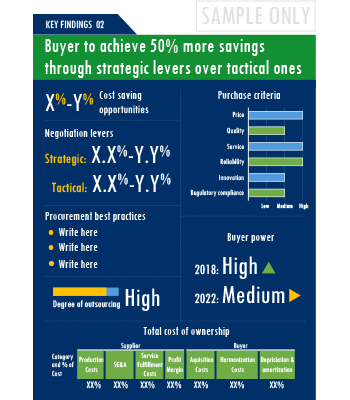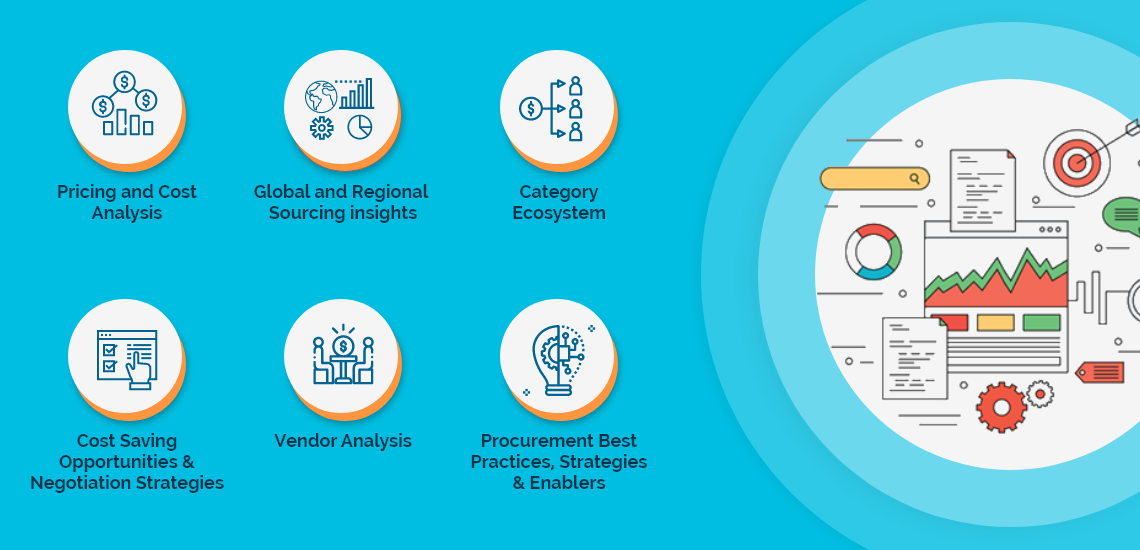A complete buyer's guide that provides comprehensive insights on Petroleum Residues category spend, spend growth and regional segmentation; in-depth price trends; negotiation levers and analysis of Petroleum Residues suppliers.
GET FREE SAMPLEThis report on global Petroleum Residues category is part of a larger series of reports on global Non-Medical Chemicals Minerals and Gases market. The scope of Non-Medical Chemicals Minerals and Gases spans multiple categories and is typically identified as a procurement category that includes all spend on procurement, transportation, conservation and storage of industrial chemicals, minerals and gases. Spend on similar products for medical and pharmaceutical usage is excluded from this category.
Non-Medical Chemicals Minerals and Gases market around the world is undergoing rapid transitions that have a massive potential to influence the way companies strategize for Petroleum Residues procurement and the cost they have to incur. Several structural changes including M&As and vertical integration efforts of suppliers are characterizing the broader market. Such strategic developments can erode the strength of previously established supplier relationships due to changed realities in the supplier's ecosystem. At the same time, buyers may also find opportunities to onboard new suppliers with a wider range of offerings or better contract terms for
It has become imperative for category managers to remain as agile as possible in terms of their procurement practices. However, it is not always easy to quickly spot and implement alternative practices in a category like Petroleum Residues. To help quick decision making, this report advises on several procurement best practices that have worked well for category managers. For example, Buyers should assess the level of adoption of the latest technologies by suppliers to assess cost-saving opportunities and quality that can be provided by the latter. For instance, the adoption of technologies such as cloud computing will enable suppliers to reduce their internal computing hardware requirements for operations such as CAD and CAM. This can, in turn, enable them to reduce their operating costs, thereby suppliers can offer products at lower rates to buyers.Strong R&D focus is the sign of a supplier committed to enhancing the quality and cost proposition of its solutions. Buyers should collaborate with such suppliers for development of low-cost but highly efficiency products that can bring their OPEX down.Buyers should engage with suppliers that have adopted a global delivery model as it reduces buyers' risk. In this model, any disaster/emergency at any operating facility of supplier will result in the work being transferred to a different facility, thereby ensuring continuity of the project and reduced risk for buyers. This model also provides buyers access to skilled labor from across the globe, thereby improving the quality of engineering products provided by the supplier.
Activate your free account to gain easy access to cutting edge research and insights on consumers, emerging price trends, global and regional suppliers.
Petroleum Residues procurement managers also need to proactively identify and mitigate potential risks that can arise in the supply chain or contracts for Petroleum Residues procurement. Some examples include:
For detailed insights and complete access to our report library, activate your free account!
The report is intended to serve as a one-stop reference guide for Petroleum Residues procurement strategy and offers a perfect blend of category basics with deep-dive category data and insights. Therefore, it is ideal for category beginners looking for “Petroleum Residues: Procurement Report 101” as well as for category experts actively tracking the global Petroleum Residues procurement market.
You may have just initiated your research to design a winning Petroleum Residues procurement strategy, or you may be a category expert looking for strategic insights and updated data.Either ways, the report has your requirements covered.

Unlock SpendEdge's comprehensive procurement report collection with ease through our procurement platform.
Procurement decisions can prove to be costly in the absence of careful deliberation and evaluation of every available option. In fact, more than 90% of the decision makers we work with acknowledge that timely availability of up-to-date category intelligence can help them make better purchasing decisions. More than 80% of them believe that in-house category intelligence needs to be updated periodically to achieve full benefits. If you have read so far, we are quite sure you agree!!
The Petroleum Residues procurement report helps take more informed decisions by placing all the critical information and advice at the fingertips of a decision maker. It also specifically answers some of the key questions that we have been routinely asked during our industry outreach initiatives:
SpendEdge Insights has helped procurement professionals and sourcing teams manage multiple spend areas and achieve more than $2 billion in savings. Activate your free account today!
The Petroleum Residues market report offers a complete picture of the supply market and analyzes the category from the perspective of both buyers and suppliers. Analysis of the category trends, procurement best practices, negotiation levers and overall category management strategy advisory are interspersed with in-depth data and commentary on spend outlook, pricing ecosystem and supplier landscape drilled down to a region-level coverage.

A key highlight of this report is the in-depth outlook created on Petroleum Residues procurement spend and pricing trends. The report further delves deep into the aspects of cost structure, total cost of ownership and supplier margins for Petroleum Residues. A dedicated section to supplier profiles and evaluation helps decision makers cast a wider procurement net and identify gaps in existing relationships.

Along with specific category and supplier intelligence, the publication also includes curated insights on Petroleum Residues market trends, price influencers and inherent risks. These insights help the decision makers prepare for market shaping trends in advance and create alternative strategies for changes in the market conditions.

Additionally, the report also advises on the best practices and strategies to manage the Petroleum Residues category efficiently. Negotiation levers and opportunities are explained in detail along with quantification of their potential. Benchmark KPIs for supplier and buyer performance management are also aggregated to better organize the category objectives. Other themes of advisory include ideal procurement organization structure, enablers to achieve KPIs or category objectives and ideal SLAs to have with suppliers.






Our research is complex, but our reports are easy to digest. Quantitative analysis and exhaustive commentary is placed in an easy to read format that gives you an in-depth knowledge on the category without spending hours to figure out “what does it mean for my company?”


SpendEdge presents a detailed picture of Petroleum Residues procurement solutions by way of study, synthesis, and summation of data from multiple sources. The analysts have presented the various facets of the market with a particular focus on identifying the key category influencers. The data thus presented is comprehensive, reliable, and the result of extensive research, both primary and secondary.

Global Anti-Corrosion Oils Market - Procurement Intelligence Report

Global Petroleum Jelly Market - Procurement Intelligence Report

Global Gasoline Additive Market - Procurement Intelligence Report

Global Motor Oils Market - Procurement Intelligence Report

Global De-Icing Agents Market - Procurement Intelligence Report

Global Fire-Extinguisher Agents Market - Procurement Intelligence Report

Global Reductor Oils Market - Procurement Intelligence Report

Global Processed Plywood Market - Procurement Intelligence Report

Global Lubricating Traction Oils Market - Procurement Intelligence Report
Access this report and our entire procurement platform | Plans starting from USD 3000/ Year Buy Now
Copyright © 2024 Infiniti Research Limited. All Rights Reserved. Privacy Notice – Terms of Use – Sales and Subscription
Cookie Policy
The Site uses cookies to record users' preferences in relation to the functionality of accessibility. We, our Affiliates, and our Vendors may store and access cookies on a device, and process personal data including unique identifiers sent by a device, to personalise content, tailor, and report on advertising and to analyse our traffic. By clicking “I’m fine with this”, you are allowing the use of these cookies. You may change your settings based on a legitimate interest at any time, by selecting “Manage Settings” on our site. Please refer to the help guide of your browser for further information on cookies, including how to disable them. Review our Privacy & Cookie Notice.
